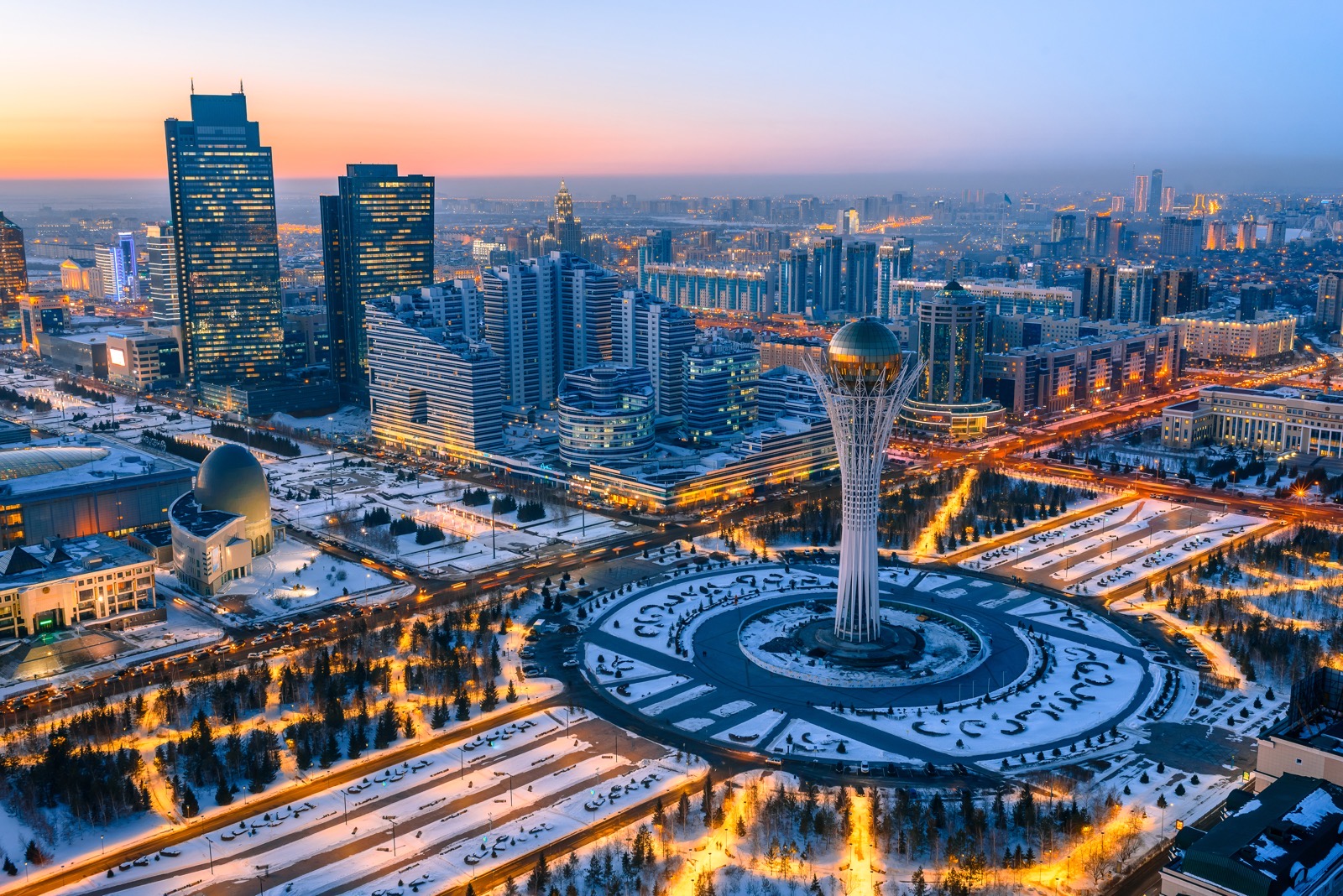The unprecedented social unrest that shocked Kazakhstan a year ago has pushed its government, once again, to lay out an agenda for accelerating the process of the country’s economic diversification.

Astana. Photo credit: Shutterstock
Kazakhstan’s oil and gas sector currently accounts for nearly half of the country’s GDP and around 70 percent of its exports. This sector generates more than a third of Kazakhstan’s fiscal revenue. Given this reliance on revenue from oil and gas, it is obvious that the high volatility of global energy prices poses significant risks for the economy.
Contributing to the challenges faced by the economy is the fact that Kazakhstan’s most significant economic activity is concentrated in industries that are not labor-intensive and thus employ a relatively small number of people. While non-oil sectors such as agriculture, construction and trade have a high employment potential, they often use unrecorded labor for seasonal short-term contracts. While jobs may be more plentiful in these sectors, the wages, benefits and job security of these positions are not comparable to conditions in the jobs offered in the oil industry.
Kazakhstan’s heavy dependence on extractive industries has historic roots. During the Soviet era, Kazakhstan was integrated into the centralized system of the USSR as a highly specialized supplier of raw materials. It also served as a location for heavy industries and as an area for agricultural production. The Soviet pattern of production and an awkward transportation infrastructure made Kazakhstan extremely dependent on other republics for non-oil products such as chemicals, machinery, food, and items produced by light industry.
When the Soviet Union collapsed in 1991, Kazakhstan, along with fourteen other republics, set out on a new and unknown course as an independent state. Facing economic chaos, Kazakhstan could not afford to rebuild its industrial structure and invest in industries that were not able to cope with import competition — such as machine-building, manufacturing construction materials, chemical production, light industry and the like. Instead, the country focused on developing sectors such as oil and gas and ferrous and nonferrous metallurgy.
These industries were able to attract large flows of foreign direct investment relatively quickly, seize increased export opportunities, bring in quick cash, support the country’s development and maintain standards of living for the population. Since then, most of Kazakhstan’s economic growth has continued to be based on the exploitation of its natural resources.

Assel Nussupova
The occasional downturns of oil and other commodity prices, however, have increased Kazakhstan’s vulnerability to external shocks and constrained the country’s revenue base. For example, in 1998, after the economic collapse in Russia and a sharp drop in oil and metal prices, Kazakhstan’s real GDP contracted by 2.5 percent. This decline came after Kazakhstan had appeared to recover from the initial difficult years of a massive decline in economic output. In 2014, another oil shock put a heavy weight on Kazakhstan’s economic and investment prospects forcing the National Bank to devalue the currency and the government to cut spending on important social programs.
These challenges underscored the need for Kazakhstan to develop a clear policy to foster more diversified growth and reduce its dependence on extractive industries. According to estimates made by the Asian Development Bank, consistent reforms in key non-oil sectors such as agriculture, manufacturing, oilfield services and transit trade could improve Kazakhstan’s growth rate by 2.1 percent annually. Implementing these reforms will be extremely important given the government’s target of achieving an annual growth rate at 4-5 percent.
Some of the first attempts to diversify the Kazakh economy can be traced back to 1997, when the authorities created a National Council for Sustainable Development. The Council was a government body aimed at identifying how Kazakhstan should use any oil windfall to diversify the economy. In 2001, the government established an “oil fund,” the National Fund of the Republic of Kazakhstan, to hold extra revenues from the country’s extractive industries. The main objectives of the fund have been to stabilize budget revenue and finance infrastructure and social projects.
In 2003, in order to boost investment in non-oil sectors, the government chose a path of adopting state-directed industrial policies. First, the government announced a twelve-year plan, entitled Strategy of Industrial Innovation Development of Kazakhstan for 2003-2015. The plan, which was designed to achieve economic diversification through the promotion of target industries, set very ambitious goals such as maintaining an average annual real growth rate of 8 percent in manufacturing over the twelve-year period. As the core of the strategy, the government founded five agencies that were to facilitate investment in non-oil sectors. These agencies included, in particular, the Investment Fund and the National Innovation Fund which were to finance technological projects and help minimize risks for private investors. These institutions were also designed to develop “technology clusters” in industries such as food-processing, metallurgy, machine-building and textiles.
Kazakhstan’s experiment with the development of strategic plans and state programs continued in 2010, when the government adopted the State Program of Expedited Industrial and Innovative Development. The Program was designed to improve the competitiveness of the economy and foster its diversification through investment in infrastructure and training. In 2012, the government adopted Strategy 2050 where it laid out the strategic goal to transform Kazakhstan into a knowledge-based economy driven by the private sector. Goals related to diversification and technological development have since been reiterated in numerous medium-term strategic plans adopted by the Kazakh government.
These days, Kazakhstan’s hopes for diversifying the economy are pinned on President Kassym-Jomart Tokayev. Since assuming office over three years ago, Tokayev, a former career diplomat, has positioned himself as a political and economic reformer. His approach has included trying to develop an entrepreneurial culture and attempting to lay a foundation for an economy based on new technologies. In particular, during his first term the initiative Digital Kazakhstan was launched. This program is seen as a way to transform the Kazakh economy and boost investment in the high-tech sector.
Following Tokayev’s re-election in 2022, the government has also been tasked with shepherding reforms in agriculture, a sector that is still in need of substantial investment. In January 2023, Prime Minister Alikhan Smailov and members of his Cabinet visited regions and held a series of conferences on the subject of improving investment opportunities for agrarian communities. Despite the rosy nature of official indicators that claim almost double-digit rates of growth in agricultural production, this sector still remains a marginal source of economic activity and only a minor contributor to the country’s exports.
According to the latest data by the Economist Intelligence Unit, in 2021, the annual rate of agricultural output decreased by 2.9 percent (in real terms). Although in 2022 it grew by 3.0 percent, the agricultural sector is still not playing a key role to further economic development and diversification for Kazakhstan. This lack of impact is in spite of it being one of the biggest employers in the country, with over 12 percent of the Kazakh labor force working there.
Kazakhstan’s manufacturing potential is another area where the country wants to see progress.
During a recent Cabinet meeting on Jan. 11, Alibek Kuantyrov, Minister of the National Economy, gave a positive outlook for the manufacturing sector. He cited high rates of growth for many non-oil manufacturing industries such as food production, machine-building, auto-making, production of electrical equipment, chemical production, and light industry. While the growth numbers in these areas may seem impressive, Kazakhstan’s goods-producing industries, similar to its agricultural sector, are actually contributing very little to the country’s economic growth and exports.
According to the latest data published by the Economist Intelligence Unit, compared to mineral production’s 66 percent share in the total amount of Kazakh exports, the share for food products is only 6.2 percent, and the chemical industry contributes just 5.2 percent to the country’s exports. Meanwhile, Kazakhstan’s imports structure is heavily dominated by the products of non-oil industries such as machinery and equipment (40.6 percent of total of imports), chemicals (16.2 percent) and the products created by other high value-added industries.
Overall, it is becoming clear that the economy cannot truly prosper without a strong, diverse, and innovative manufacturing sector and an agricultural sector which not only can supply affordable goods for the domestic market and neighboring countries but also provide jobs for the majority of the Kazakh population.
Despite the fact that Kazakhstan’s economy continues to grow, the government is aware that the risk of further social unrest remains high and such unrest can be easily triggered if the government does not initiate real reforms to foster more diversified growth in the economy and provide incentives to invest in the non-oil sector.
The author is an analyst with a Master’s Degree in Economics from Georgetown University in Washington, DC, and more than 20 years of experience working for the Kazakh government. She focuses on macroeconomics, commodity and financial markets, economic and social policies in Kazakhstan and globally.


